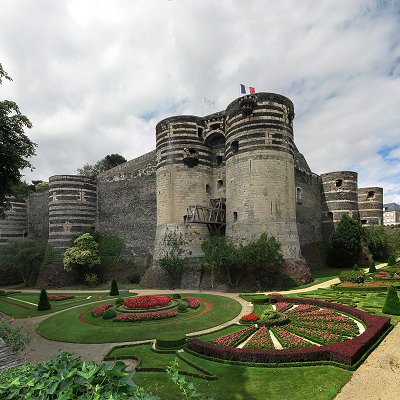
Like us on Facebook
PLACE NAMES


 
|
|
Angers
|
 |
|
Angers is a city in western France, about 300 km (190 mi) southwest of Paris. It is chef-lieu of the Maine-et-Loire department and was, before the French Revolution, the capital of the province of Anjou.
The inhabitants of both the city and the province are called Angevins. The commune of Angers proper, without the metropolitan area, is the third most populous in northwestern France after Nantes and Rennes and the 17th in France.
Angers is the historical capital of Anjou and was for centuries an important stronghold in northwestern France. It is the cradle of the Plantagenet dynasty and was during the reign of René of Anjou one of the intellectual centers of Europe. Angers developed at the confluence of three rivers, the Mayenne, the Sarthe, and the Loir, all coming from the north and flowing south to the Loire. Their confluence, just north of Angers, creates the Maine, a short but wide river that flows into the Loire several kilometers south. The Angers metropolitan area is a major economic center in western France, particularly active in the industrial sector, horticulture, and business tourism.
Angers proper covers 42.70 square kilometers (16.5 sq mi) and has a population of 147,305 inhabitants, while around 394,700 live in its metropolitan area. The Angers Loire Métropole is made up of 33 communes covering 540 square kilometers (208 square miles) with 287,000 inhabitants.
Angers enjoys a rich cultural life, made possible by its universities and museums. The old medieval center is still dominated by the massive château of the Plantagenâts, home of the Apocalypse Tapestry, the biggest medieval tapestry ensemble in the world. Angers is also both at the edge of the Val de Loire, a World Heritage Site, and the Loire-Anjou-Touraine regional natural park.
The Château d'Angers, built on a schist promontory, dominates the river Maine and the old town. Its site has been occupied since antiquity; the castle itself was built between 1230 and 1240 by Louis IX of France. The massive walls are about one kilometer long and punctuated by 17 towers; they were built with horizontal slices of tuff and schist, giving it strength and an original striped look. During the 15th century, a chapel and the Châtelet were added in the courtyard.
The Maison d'Adam ("Adam's House"), located behind the cathedral, is an excellent example of the half-timbered houses which were built during the Middle Ages. Many similar houses, although smaller, are also visible along the streets around the castle. The city also displays several Renaissance and classical hotels particuliers, the most renowned being the Logis Pincé from the 16th century. The Maison bleue ("Blue House"), built in 1927, is an Art Deco masterpiece. The former seat of the French Aviation Company (Compagnie française d'Aviation) was built in 1938 and abandoned during the Second World War. Totally refurbished in 2004, it is now a testimony to 1930s architecture.
The Saint-Maurice cathedral is a major landmark in the cityscape, with its two spires culminating at 75 meters (246 ft). The construction of the current building started during the 12th century on the remains of an older sanctuary. The original structure, romanesque, received gothic columns and vaults in the middle of the 12th century, giving birth to the Angevin gothic, a style that quickly spread in Western France and the Angevin possessions in Italy. Sculptures and architectural details were added to the façade during the 16th century. The twin spires were built in 1518 and 1523. The neighbouring Palais du Tau, the former episcopal palace, dates from the 12th century.
The skyline is also marked by the Tour Saint-Aubin. Completed in 1170, it was the bell-tower of an abbey closed during the French Revolution and destroyed in 1810. Elaborately sculptured 11th and 12th century arcades also survive in the courtyard of the Prefecture.
Another abbey, the Abbaye Toussaint, founded during the 13th century, was also partially pulled down and only the church and parts of the cloister are still visible. On the southern limits of the commune, close to the Maine, stands the Couvent de la Baumette, founded during the 15th century by René of Anjou.
La Doutre, an old quarter located on the western bank of the Maine and facing the castle, contains two major medieval sites, the former Abbaye du Ronceray, built during the 11th and 12th century, and the Hôpital Saint-Jean, founded by Henry II of England and used as the city hospital until 1870.
 Feel free to Email me any additions or corrections Feel free to Email me any additions or corrections
LINKS AVAILABLE TO YOUR SITE
| | |





